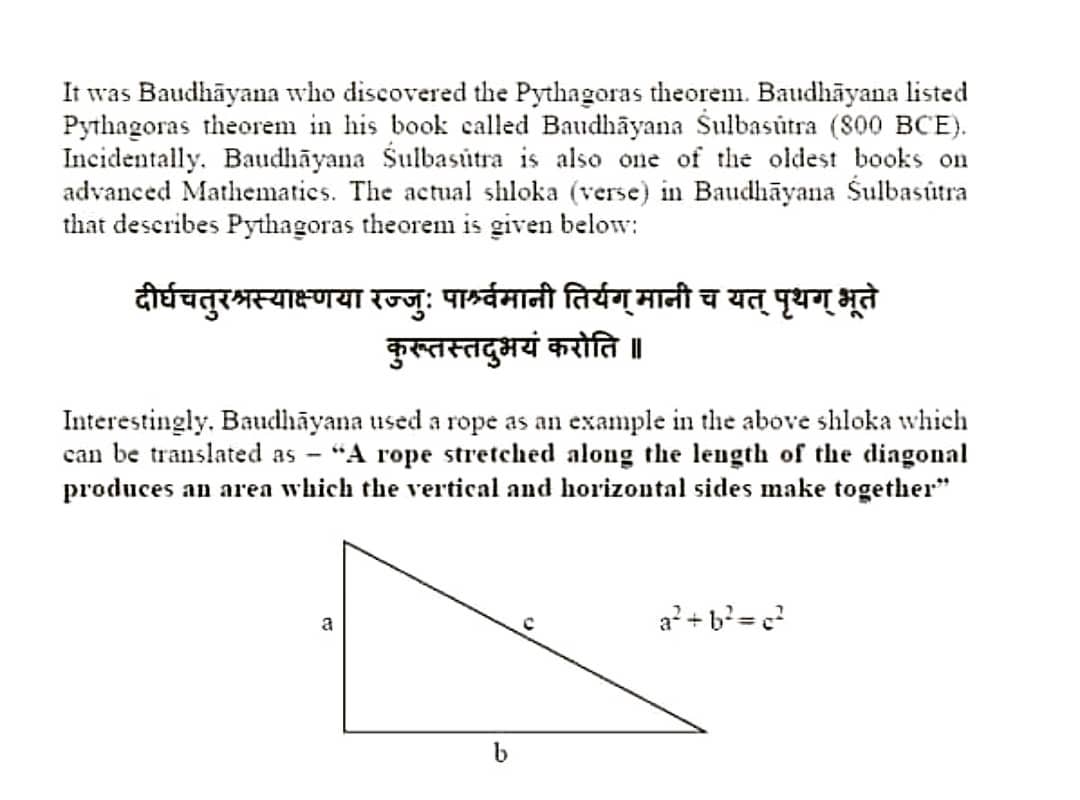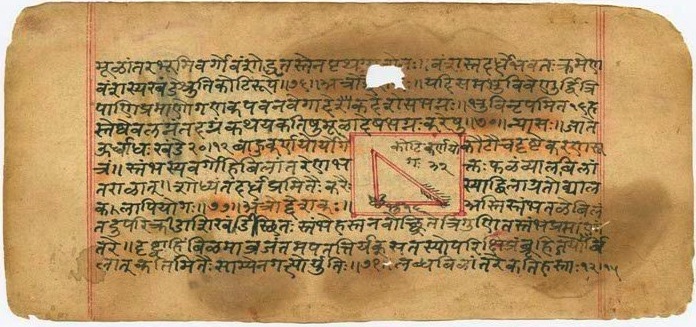Do you know?
Baudhayan–the great Indian Mathematician gave Pythagoras Theorem,accredited with calculating the value of pi(π) in 2000 BC.
Proof of Pythagoras theorem has been provided by both Baudhāyana & Āpastamba in their Sulba Sutras,giving rules for the construction of altars.
Baudhayan–the great Indian Mathematician gave Pythagoras Theorem,accredited with calculating the value of pi(π) in 2000 BC.
Proof of Pythagoras theorem has been provided by both Baudhāyana & Āpastamba in their Sulba Sutras,giving rules for the construction of altars.
दीर्घचतुरश्रस्याक्ष्णया रज्जु: पार्श्र्वमानी तिर्यग् मानी च यत् पृथग् भूते कुरूतस्तदुभयं करोति ॥
A rope stretched along the length of the diagonal produces an area which the vertical and horizontal sides make together.
A rope stretched along the length of the diagonal produces an area which the vertical and horizontal sides make together.
The Baudhāyana Sulba Sūtra states the rule referred to today in most of the world as the Pythagorean Theorem. The rule was known to a number of ancient civilizations, including also the Greek and the Chinese, and was recorded in Mesopotamia as far back as 1800 BCE.
The Baudhāyana sūtras are a group of Vedic Sanskrit texts which cover dharma, daily ritual, mathematics, etc. They belong to the Taittiriya branch of the Krishna Yajurveda school and are among the earliest texts of the genre, perhaps compiled in the 8th to 6th centuries BCE.
The Baudhayana sūtras consist of six texts:
1.the Śrautasûtra, probably in 19 Praśnas (questions),
2.the Karmāntasûtra in 20 Adhyāyas (chapters),
3.the Dvaidhasûtra in 4 Praśnas,
4.the Grihyasutra in 4 Praśnas,
5.the Dharmasûtra in 4 Praśnas and
6.the Śulbasûtra in 3 Adhyāyas.
1.the Śrautasûtra, probably in 19 Praśnas (questions),
2.the Karmāntasûtra in 20 Adhyāyas (chapters),
3.the Dvaidhasûtra in 4 Praśnas,
4.the Grihyasutra in 4 Praśnas,
5.the Dharmasûtra in 4 Praśnas and
6.the Śulbasûtra in 3 Adhyāyas.
The Baudhāyana Śulbasûtra is noted for containing several early mathematical results, including an approximation of "the square root of 2" and the statement of the "Pythagorean theorem."
The diagonal and sides referred to are those of a rectangle, and the areas are those of the squares having these line segments as their sides. Since the diagonal of a rectangle is the hypotenuse of the right triangle formed by two adjacent sides.
the statement is seen to be equivalent to the Pythagorean theorem.
Baudhāyana also provides a statement using a rope measure of the reduced form of the Pythagorean theorem for an isosceles right triangle:
The cord which is stretched across a square produces an area double the size of the original square.
The cord which is stretched across a square produces an area double the size of the original square.
src :
1. #v=onepage&q=Is%20also%20rather%20vague&f=false">https://books.google.co.in/books?id=DHvThPNp9yMC&pg=PA345&lpg=PA345&dq=Plofker,+Kim+(2007&redir_esc=y&hl=en #v=onepage&q=Is%20also%20rather%20vague&f=false
2.">https://books.google.co.in/books... https://www.sacred-texts.com/hin/sbe14/sbe1403.htm
3.">https://www.sacred-texts.com/hin/sbe14... S. Balachandra Rao, Indian Mathematics and Astronomy: Some Landmarks. Jnana Deep Publications, Bangalore, 1998. ISBN 81-900962-0-6
1. #v=onepage&q=Is%20also%20rather%20vague&f=false">https://books.google.co.in/books?id=DHvThPNp9yMC&pg=PA345&lpg=PA345&dq=Plofker,+Kim+(2007&redir_esc=y&hl=en #v=onepage&q=Is%20also%20rather%20vague&f=false
2.">https://books.google.co.in/books... https://www.sacred-texts.com/hin/sbe14/sbe1403.htm
3.">https://www.sacred-texts.com/hin/sbe14... S. Balachandra Rao, Indian Mathematics and Astronomy: Some Landmarks. Jnana Deep Publications, Bangalore, 1998. ISBN 81-900962-0-6
4. Vincent J. Katz. A History of Mathematics: An Introduction, 2nd Ed. Addison-Wesley, 1998. ISBN 0-321-01618-1
5. http://mathshistory.st-andrews.ac.uk/Biographies/Baudhayana.html
6.">https://mathshistory.st-andrews.ac.uk/Biographi... http://mathshistory.st-andrews.ac.uk/HistTopics/Indian_sulbasutras.html
7.">https://mathshistory.st-andrews.ac.uk/HistTopic... http://mathshistory.st-andrews.ac.uk/Projects/Pearce/Chapters/Ch4_2.html
8.">https://mathshistory.st-andrews.ac.uk/Projects/... B.B. Dutta."The Science of the Shulba".
5. http://mathshistory.st-andrews.ac.uk/Biographies/Baudhayana.html
6.">https://mathshistory.st-andrews.ac.uk/Biographi... http://mathshistory.st-andrews.ac.uk/HistTopics/Indian_sulbasutras.html
7.">https://mathshistory.st-andrews.ac.uk/HistTopic... http://mathshistory.st-andrews.ac.uk/Projects/Pearce/Chapters/Ch4_2.html
8.">https://mathshistory.st-andrews.ac.uk/Projects/... B.B. Dutta."The Science of the Shulba".
Correction : Baudhayana (about 2800 years ago)

 Read on Twitter
Read on Twitter



